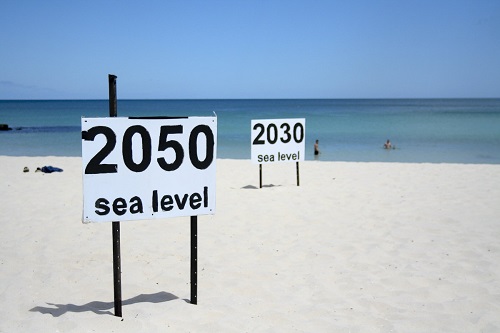
Global warming is an imminent threat to entire humanity. The rising temperatures of seas and earth surface results in irregular seasons, high intensity hurricanes and other weather disasters that can potentially lead to droughts, mass migrations, food scarcity, economic and political turmoil. Raising sea levels is one such threat and it can submerge islands that are vulnerable as a virtue of their geography. But how does raising temperatures cause raising sea levels? For that matter how heat causes melting of solids? Lets discuss the answers in the following sections.
Matter is made up of atoms and molecules. Atoms come together and form bonds to make molecules. Some atoms, inert atoms, do not form bonds as such but inter-atomic forces do exist even in these cases. Intermolecular forces like van der Waals forces and hydrogen bonds bind molecules together. The molecules in a solid are bound together by very strong forces whereas molecules in a liquid are bound by intermediately strong forces and in the case of gases the force of attraction between molecules is almost negligible. A conversion of solid to liquid or gas requires energy. This energy helps the molecules get rid of the effect of intermolecular forces. Heat energy, generally, serves the purpose.
When a solid substance is heated the heat energy transferred is used in breaking these inter-molecular bonds and weakening them. During our Physics tuition classes, we learnt that this also increases the internal potential energies of the molecules. Hence when solids are heated, liquid and gaseous form the substance are formed. The process of conversion of solids to liquids is called as melting and the temperature at which this process takes place is called as melting point. (It also depends on the nature of the substance as some substances disintegrate before the temperature reaches their melting point). The conversion of liquids to gases is called boiling and the temperature at which boiling occurs is called as boiling point. Sometimes solids directly get converted to gases through a process called as sublimation.
Secondly the volume of a substance increases as it changes from solid to liquid and gas. Three fourths of the earth’s surface is covered by water in the form of seas, oceans and polar icecaps. The polar ice caps store large amounts of water in its solid form. Since the volume occupied by liquids is higher than that of solids, for given mass of water the amount of liquid (in terms of its volume) is higher than that of its solid counterpart. So rise in temperatures cause the conversion of solid polar ice caps to liquid water. Because of this the amount of water in the oceans increases leading to raising sea levels consequently submerging islands. Island nations like Maldives are vulnerable to such drastic effects of global warming.
